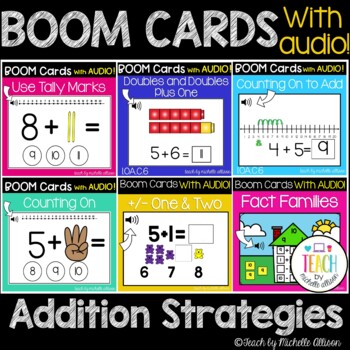Summer Boom Cards for Addition & Subtraction Within 20 - Math Boom Cards
- Zip
What educators are saying
Products in this Bundle (6)
showing 1-5 of 6 products
Also included in
- Grab this bundle for back to school to school! Your students will love this year-long bundle of math Boom Cards! If you are looking for no-prep math games, these Boom Cards are the answer! This year-long bundle includes 20 decks of math Boom Cards with Audio. The bundle includes addition strategiPrice $45.80Original Price $57.25Save $11.45
Description
Your students are going to love these for summer Boom Card practice! Perfect for fact fluency practice and addition and subtraction within 20. This bundle includes 6 decks of Boom Cards including using tally marks, doubles and doubles plus one, counting on with a number line, counting on with fingers, plus 1 and plus 2, counting to add, and fact families. This bundle of BOOM Cards is the perfect addition (pun intended!) to your teacher toolkit! Each card includes a pictorial representation and audio to help students with independence.
Use this deck to model a lesson during whole group instruction, reinforce skills in small groups, as independent word work centers, as a formative assessment, or as part of your data collection for RTI intervention!
WHAT'S INCLUDED?
This resource includes a PDF document with a link to download the Boom Cards hosted on BOOM Learning: Addition Strategies for First Grade BUNDLE! | Distance Learning
Related Products
⭐ Hundreds Chart | Missing Numbers | Understanding Place Value | Math BOOM Cards™
⭐ Skip Counting | Number Puzzles | BOOM Cards™ for Math
⭐ Fact Families | Addition Strategies | Subtraction Strategies | BOOM Cards™
Terms
Copyright © Michelle Staley. All rights reserved by the author. This product is to be used by the original downloader only. Copying for more than one teacher, classroom, department, school, or school system is prohibited. This product may not be distributed or displayed digitally for public view. Failure to comply is a copyright infringement and a violation of the Digital Millennium Copyright Act (DMCA). Clipart and elements found in this PDF are copyrighted and cannot be extracted and used outside of this file without permission or license. Intended for classroom and personal use ONLY. See product file for clip-art and font credits.
Important Information From BOOM Learning
Using Boom Cards: To use Boom Cards, you must be connected to the Internet. Boom Cards play on modern browsers (Chrome, Safari, Firefox, and Edge). Apps are available for Android, iPads, iPhones, and Kindle Fires. For security and privacy, adults must have a Boom Learning account to use and assign Boom Cards. You will be able to assign the Boom Cards you are buying with "Fast Pins," (play provides instant feedback for self-grading Boom Cards). Fast Play is always a free way for students to engage with Boom Cards decks. For additional assignment options, you'll need a premium account. If you are new to Boom Learning, you will be offered a free trial of our premium account. Read here for details: http://bit.ly/BoomTrial.
Common Core State Standard Correlations:
Represent and solve problems involving addition and subtraction.
CCSS.MATH.CONTENT.1.OA.A.2
Solve word problems that call for the addition of three whole numbers whose sum is less than or equal to 20, e.g., by using objects, drawings, and equations with a symbol for the unknown number to represent the problem.
Add and subtract within 20.
CCSS.MATH.CONTENT.1.OA.C.5
Relate counting to addition and subtraction (e.g., by counting on 2 to add 2).
CCSS.MATH.CONTENT.1.OA.C.6
Add and subtract within 20, demonstrating fluency for addition and subtraction within 10. Use strategies such as counting on; making ten (e.g., 8 + 6 = 8 + 2 + 4 = 10 + 4 = 14); decomposing a number leading to a ten (e.g., 13 - 4 = 13 - 3 - 1 = 10 - 1 = 9); using the relationship between addition and subtraction (e.g., knowing that 8 + 4 = 12, one knows 12 - 8 = 4); and creating equivalent but easier or known sums (e.g., adding 6 + 7 by creating the known equivalent 6 + 6 + 1 = 12 + 1 = 13).






